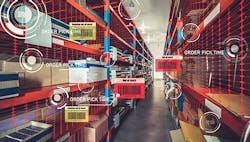Yaqing Sun is corporate industry development manager—logistics at Omron Automation.
What sorts of sensing technologies have improved the effectiveness and reliability of picking systems and conveyance systems?
Yaqing Sun, corporate industry development manager—logistics, Omron Automation: RFID used for asset tracking and location, barcode identification traceability, camera AI-based image identification and 3D-based time-of-flight dimensioning sensing are a few technologies that have improved the effectiveness and reliability of picking and moving the correct product from goods to person or person to goods.
Also read: Warehouses continue to improve efficiency with collaborative robots, AMRs and AGV technology
Which technologies have allowed warehouses to increase throughput rates while expanding product ranges and still maintaining accurate order fulfillment?
Yaqing Sun, corporate industry development manager—logistics, Omron Automation: As many warehouse managers might be applying AI to better predict customer demand, AI in conjunction with IIoT can also be applied to minimize machinery downtime to ensure smooth operations. Combining “beers and diapers” might sound like an excellent analytical finding to drive up revenue, but to minimize costs for operations and downtime is equally important, in order to keep a sustainable profitability.
Modern warehouse machinery can consider applying AI in multiple scenarios; here are examples we see frequently from customers:
- Predictive maintenance: using sensors to monitor machine usage and prevent machine breakdown. For example, a motor sensor could signal jams on conveyors; thermal sensors could signal a troubled motor, too. These signals can be shared with on-site maintenance engineers before an actual breakdown occurs.
- Error handling: by applying AI imaging, packing machines can filter incorrect orders for manual interference, instead of routing down the wrong path and causing extra time and costs.
- Inventory tracking: traceability technologies and warehouse database communication are helping drive efficiencies and accuracies. Inventory can be 100% located and accounted for, which drives efficiencies with intelligence to create pick location strategies. Combined together, reliable picking of product from the most effective location derived by intelligence reduces errors and pick time, which is key to keeping up with customer demand.
Because of the warehouse’s physical nature, how much of the facility’s hardware can be replaced with software in order to facilitate easier upgrades, expansions and reconfigurations?
Yaqing Sun, corporate industry development manager—logistics, Omron Automation: If software—information technology—is to provide the intelligence and hardware—operation technology—is to execute the decision, a trend we observe is that IT and OT are coming closer together. Traditionally strong software companies like Amazon are entering the logistics facilities; for example, the AWS RoboRunner project is aiming to bring in autonomous mobile robots (AMRs) from different vendors under one platform. Also, many hardware companies are bringing intelligence into the device level so that calculation and decision making can happen at the machine level. This will allow faster and more secure and reliable machinery control. Edge computing offers warehouse managers the option to leave time-sensitive machinery controls at the machine level, while performing facility-level monitoring and maintenance at a centralized location for long-term performance improvements.
How have automated storage and retrieval systems' roles changed over the past 10 years?
Yaqing Sun, corporate industry development manager—logistics, Omron Automation: Growth of ecommerce business is driving the change for automated storage and retrieval system (AS/RS) upgrades. This is accompanied by the demands for customized product manufacturing; think of how you configure your car or design a customized pair of shoes. Because of these changes in customer behaviors, many warehouses are moving from a business-to-business (B2B) service model to an essentially business-to-consumer (B2C) service model. For this reason, AS/RS is moving from pallet storing and case retrieving to case storing and singular item retrieving. As technology and space become more affordable over time, AS/RS will evolve more into micro-fulfilment in order to meet the demand of individual customers.
Will autonomous mobile robots replace automated guided vehicles altogether, or is there room for both, based on the application or complementary functions?
Yaqing Sun, corporate industry development manager—logistics, Omron Automation: The main difference between an AMR and an automated guided vehicle (AGV) is the navigation system. While AMR is based on natural navigation, AGV requires additional assistance, for example, bar codes, magnet tapes or rails. In my opinion, the speed advantage of AGVs over AMRs cannot overset the disadvantages of its high maintenance costs—repair of tapes on the floor—and the infrastructure inflexibility. Modern warehouses require high agility to meet seasonable demands and SKU changes. Again, using the beers-and-diapers example, a world pandemic might change this popular bundle into “toilet papers and home office appliances.” It will take an engineer much longer time to change a fixed AGV system to meet these new demands, if possible at all, in comparison to a few clicks in an AMR system with a good fleet management system.
Given the extraordinary percentage of manual operation in most distribution centers, will the 24/7 fully autonomous warehouse order-fulfillment center ever become commonplace?
Yaqing Sun, corporate industry development manager—logistics, Omron Automation: We believe that technologies are not invented to replace human laborers, but to assist human laborers in performing better jobs. While a 24/7 fully autonomous fulfilment or distribution center is certainly imaginable, we expect human supervisions to oversee machinery status, to design and adjust machinery functions and to set up and perform machinery safety inspections.
Different warehouse conditions drive the need and ROI to justify the cost of the levels of automation. Space, flexibility, throughput, traceability needs, product size and weight, scalability, seasonal demand, workforce skill and availability are few of these factors that determine the viability of the requirement for 24/7 fully autonomous warehouses. While the desire for fully autonomous warehouse order fulfillment is a common desire by the industry, cost associated with the automation is an aspect to consider, as well. However, we do expect advanced warehouse technologies to become more affordable in coming years as the adoption rates pick up, which drives down the costs.
Mike Bacidore is the editor in chief for Control Design magazine. He is an award-winning columnist, earning a Gold Regional Award and a Silver National Award from the American Society of Business Publication Editors. Email him at [email protected].
About the Author
Mike Bacidore
Editor in Chief
Mike Bacidore is chief editor of Control Design and has been an integral part of the Endeavor Business Media editorial team since 2007. Previously, he was editorial director at Hughes Communications and a portfolio manager of the human resources and labor law areas at Wolters Kluwer. Bacidore holds a BA from the University of Illinois and an MBA from Lake Forest Graduate School of Management. He is an award-winning columnist, earning multiple regional and national awards from the American Society of Business Publication Editors. He may be reached at [email protected]

Leaders relevant to this article:



